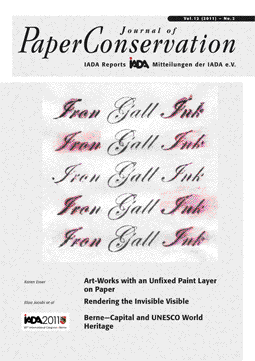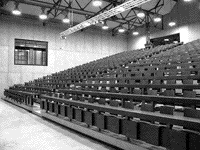VOL.
12 (2011), NO. 2

|
|
|
|
|
ART WORKS WITH AN UNFIXED PAINT LAYER
ON PAPER
Guidelines for Handling and Transport
KUNSTOBJEKTE MIT EINER NICHT-FIXIERTEN
MALSCHICHT AUF PAPIER
Richtlinien für das Hantieren und den Transport
Authors/Autoren: Karen
Esser
Abstract: Works on paper with
an unbound, porous pigment layer such as pastel and charcoal constitute
a special challenge in a museum context, as the delicate and loose
structure of these media is incredibly vulnerable, especially to
touch and vibrations. Special consideration and care in connection
with both handling and transport is required. In art museums whose
primary mandates are presentation and preservation, these materials
represent a well-known problem. The result is that often these types
of work are rarely exhibited, and their stories untold. With the
aim of reversing this problem, the possibilities of optimizing the
present handling and transport strategies for such vulnerable objects
were studied. During the research, the physical conditions in the
National Gallery of Denmark were studied, and the level of shock
and vibration to which the museum's works of art are exposed on
a daily basis, through handling and transport was measured. The
idea was to identify good and bad routines, in order to facilitate
the implementation of improved measures. The shock and vibration
were measured with a data-logger, which records the acceleration
of the object being monitored along three axes. This can demonstrate
to what extent an object has been exposed to vibration. The results
of the measurements show the clear difference between the level
of vibration from a trolley with massive rubber wheels and a trolley
with pneumatic tyres. In addition this study demonstrates that works
transported in a vertical position are more inclined to loss of
pigment than works that are transported horizontally. To avoid damage
from direct contact with the artwork, the best solution is to frame
the works behind glass, or alternatively in a passe-partout cut
deeply in front and with a stable backing.
Zusammenfassung: Papierobjekte
mit einer ungebundenen, porösen Pigmentschicht wie Pastelle
und Kohlezeichnungen stellen für Museen eine besondere Herausforderung
dar, da die empfindliche und lose Struktur dieser Farbaufträge
besonders durch Berührung und Vibration gefährdet ist.
Vorsicht während des Hantierens und Transports ist daher dringend
erforderlich. Für Kunstmuseen, deren primäre Aufgabe Präsentation
und Konservierung ihrer Sammlung darstellt, sind diese Objekte ein
bekanntes Problem. Als Konsequenz werden sie selten ausgestellt.
Um dieses Problem anzugehen, wurden die Möglichkeiten einer
Optimierung der derzeitigen Hantierungs- und Transportstrategien
für diese Objekte untersucht. Im Rahmen des Projektes wurden
die physikalischen Bedingungen der dänischen Nationalgalerie
untersucht und die Schock- und Vibrationsbelastungen, denen die
Kunstwerke im Museumsalltag ausgesetzt sind, ermittelt. Gute und
schlechte Routinehandlungen wurden identifiziert, um optimierte
Arbeitsabläufe zu implementieren. Die Schock- und Vibrationsbelastung
wurde mit Dataloggern ermittelt, welche Schwingungen über drei
Achsen erfassen. Hiermit kann nachgewiesen werden, in welchem Umfang
ein Objekt Vibrationen ausgesetzt wurde. Die Meßergebnisse verdeutlichen
den Unterschied zwischen der Vibrationsbelastung von Trolleys mit
massiven Gummirädern bzw. luftgefüllten Reifen. Auch zeigt
diese Studie, daß vertikal transportierte Werke eher einen Pigmentverlust
aufweisen als solche, die horizontal transpotiert wurden. Die beste
Lösung, um Schäden durch direkten Kontakt mit Kunstwerken
zu vermeiden, ist eine Aufbewahrung in verglasten Rahmen oder, als
Alternative, in Passepartouts mit vertieftem Ausschnitt und einer
stabilen Rückwand.
Keywords: Current State of Knowledge
- Methodology (Materials - Trolleys - Storage and Routes - Data-Logger
- Evaluation) - Five Test Sections (Trolleys and Routes - Pastel
and Charcoal - Measures for Improvement - Handling in Storage -
Long Distance Travel) - Results and Discussion (Trolleys and Routes
- Pastel and Charcoal - Measures for Improvement - Handling in Storage
- Long Distance Travel) - Conclusions and Recommendations - Acknowledgements
- Endnotes - References - Suppliers - Author
|
|
RENDERING THE INVISIBLE VISIBLE
Preventing Solvent-Induced Migration During Local Repairs on Iron
Gall Ink
DAS UNSICHTBARE SICHTBAR MACHEN
Reduzierung der lösemittel-induzierten Migration bei Rißschließungen
tintenfraßgeschädigter Papiere
Authors/Autoren: Eliza
Jacobi, Birgit
Reissland, Claire
Phan Tan Luu, Bas van
Velzen, Frank
Ligterink
Abstract: Local mending of ink-corroded
areas with a water-based adhesive bears one serious risk: too much
moisture transports invisible, detrimental compounds like iron(II)
ions and acids out of the ink lines into surrounding paper areas,
spreading ink corrosion. This process becomes perceptible just after
years, therefore this risk is often underestimated. Methylcellulose,
Klucel® G, Gelatine, Wheat starch, Methylcellulose/Starch mixture
and RepaTex® G5 were applied with three application methods:
brushing the adhesive on the paper strip before application, brushing
the adhesive directly on the original through a Japanese paper,
and using remoistenable tissue. The transport of components was
followed by applying repairs on indicator papers with iron gall
ink lines: bathophenanthroline (iron(II) ions), methyl red (acid)
and cobaltchloride (moisture). The bathophenanthroline indicator
paper successfully allowed to compare different adhesives and application
techniques, visualizing the migration of iron(II) ions. All tested
adhesives caused iron(II) ions to migrate out of ink lines when
too much water was involved, even Klucel® G in ethanol (96 %).
Applying remoistenable tissue was the only technique that provided
an adhesive layer of equal thickness and allowed to limit the water
content so that reproducibly good results were achieved. The indicator
paper was further developed to a ready-to use product and is available
on the market.
Zusammenfassung: Rißschließen
tintenfraßgeschädigter Bereiche mit Klebstoffen auf Wasserbasis
birgt ein ernstes Risiko - das Einbringen von Wasser kann unsichtbare,
schädliche Verbindungen wie Eisen(II)-Ionen und Säuren
aus den Tintenlinien in angrenzende Papierbereiche transportieren
und damit den Tintenfraß ausbreiten. Da dieser Prozeß
erst nach Jahren sichtbar ist, wird dieses Risiko oft unterschätzt.
Methylcellulose (MC), Klucel® G, Gelatine, Weizenstärke,
MC/Stärke und RepaTex® G5 wurden mit drei Methoden aufgebracht:
Pinselauftrag auf den Japanpapierstreifen, direktes Auftragen des
Klebstoffes durch das Japanpapier und Verwendung eines selbstgefertigten
„Remoistenable Tissue“. Der Transport löslicher Komponenten
wurde sichtbar gemacht, indem auf Indikatorpapieren mit Tintenlinien
gearbeitet wurde: Bathophenanthrolin (Eisen(II)-Ionen), Methylrot
(Säure) und Kobaltchlorid (Feuchtigkeit). Alle Klebstoffe verursachten
eine Migration von Eisen(II)-Ionen, wenn sie zu feucht aufgetragen
wurden, selbst Klucel® G in Ethanol (96 %). Remoistenable Tissues
realisieren eine homogene Klebstoffschicht bei geringstmöglichem
Wassereintrag und erzielten reproduzierbar gute Ergebnisse. Das
Indikatorpapier erlaubt die Kontrolle und Optimierung der eigenen
Arbeitsweise und ist im Fachhandel erhältlich.
Keywords: Iron Gall Ink and
the Effect of Solvents - Mending Ink Corroded Areas (Support Material
- Adhesives and Ready-To-Use Products - Mending Techniques) - Experimental
(Preparation of the Indicator Papers - Applying Iron Gall Ink on
the Indicator Papers - Preparation of Adhesives - Choice of Repair
Paper - Repair Techniques Applied) - Results and Discussion (Migration
after Ink Application - Migration Due to Direct Adhesive Application
- Migration Due to Repairs - Controlling the Water Content of a
Repair) - Conclusion - Acknowledgements - Endnotes - References
- Suppliers - Authors
|
|
EDITORIAL
Continued Professional Development (Anna Bülow)
|
|
IADA NEWS
Editorial Board Meeting—Committee Meeting (Anna
Bülow) - Committee Candidates - Invitation to the IADA's
General Member's Meeting, Berne 2011 - Honorary IADA Member Johannes
Sievers Turns 80 (Gerd Brinkhus)
- Letters to the Editors: Your Views Matter to Us - Discussion:
ECCO-The European Confederation of Conservators-Restorers' Organsisation
- Berne: Capital and UNESCO World Heritage (Ulrike Bürger)
- UK-London: Clothworker's
Foundation Bursary Scheme for UK-Based Conservators
Wolfgang Jaworek—A Critical Supporter of IADA: First Steps - But
Those Were Eventful Times ... - Sustainable Cooperation - Farewell
- Thank You (André
Page and the IADA Board)
|
|
XIIth IADA CONGRESS BERNE 2011
|
|
PERSONALIA
Obituary: Annette Low-Lange (1964-2010) (Michaela Brand, Pascale
Regnault, Charlotte Ahlgren, Vendulka Cejchan, Mirah von Wicht)
|
�
|
MATERIALS & EQUIPMENT
Berlin Tissue: It's Worth Every Penny! (Claire
Phan Tan Luu, Dionysia
Christoforou)
> If you want to share information on new „Materials & Equipment“
in the field of book and paper conservation, please contact: Claire
Phan Tan Luu or Dionysia
Christoforou
|
|
INSTRUCTABLES
Repair on Iron Gall Ink with Remoistenable Tissue (Bas
van Velzen, Eliza Jacobi)
|
|
ONLINE SUPPLEMENT
LITERATURE
Recent
Publications | Neue Veröffentlichungen
Book Reviews | Rezensionen
Fine Bookbinding (Florian
Wolper)
Lindsay, Jen: Fine Bookbinding. A technical guide. New Castle:
Oak Knoll Press, 2009. 215 S., zahlr. sw-Abb. ISBN 978-1-58456-268-9.
USD 59,95. > PDF
Online Tip | Online-Tipp
Alan Buchanan Designs, London/UK:
Workshops
& Training
News (Helga Joergens-Lendrum: The
Use of Infilling with Dyed Paper Pulp)
Suggested
Readings | Zeitschriftenauswertung
TRAINING
Review | Bericht
Projekt „Nachhaltigkeit der Massenentsäuerung von Bibliotheksgut“:
Ergebnisse und Abschlußveranstaltung (Jana
Moczarski) > PDF
Training
Events | Fortbildungskalender
EXHIBITIONS
Exhibition
Calendar | Ausstellungskalender
|
|
ADVERTISEMENTS
Tru Vue, Inc.
- Optium Acrylic Products, US-McCook, IL
Werkstatt für Papier, Dipl. Ing. Gangolf Ulbricht, DE-10997
Berlin, gangolf.ulbricht@p-soft.de
Hamburger
Buntpapier Susanne Krause, DE-22559 Hamburg
Geräte, Material und Werkzeuge für Papierrestauratoren Gabi Kleindorfer, DE-84186 Vilsheim
Franz
Hoffmann, Bucheinbandleder und Pergamente, Inh. Thomas Schmidt,
DE-70197 Stuttgart
Klug
Conservation, Walter Klug GmbH & Co. KG, DE-87503 Immenstadt
Anton Glaser
Feinpapiergroßhandlung, DE-70174 Stuttgart
Deffner &
Johann GmbH, Fachgroßhandel für Restaurierungsbedarf,
DE-97520 Röthlein
Hans Schröder
GmbH, DE-76689 Karlsdorf-Neuthard
Karthäuser-Breuer
GmbH, DE-50777 Köln
Föll-Vertriebs-GmbH,
DE-50777 Köln
Schempp Bestandserhaltung
GmbH, DE-70806 Kornwestheim
Halbe-Rahmen GmbH,
DE-Kirchen/Sieg
Römerturm
Feinstpapier GmbH & Co KG, DE-Frechen
Buchbinder-Colleg,
DE-Stuttgart (Insert)
|


![]() [Feedback]
[Feedback]

